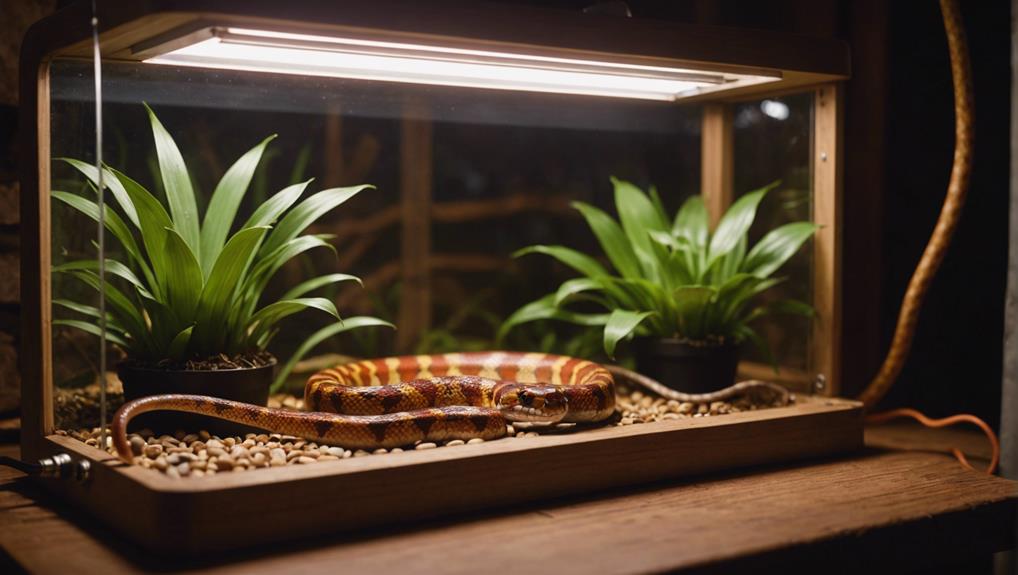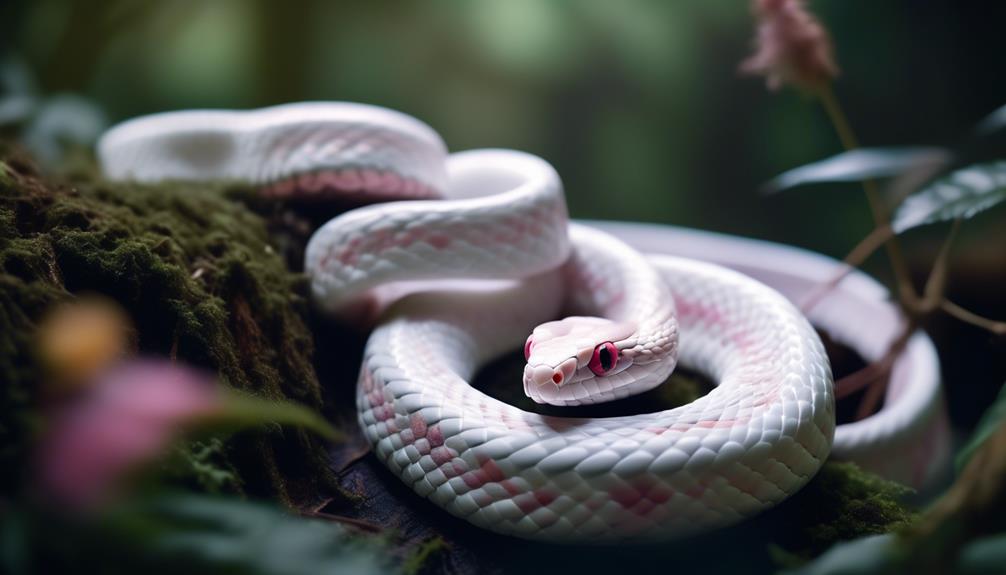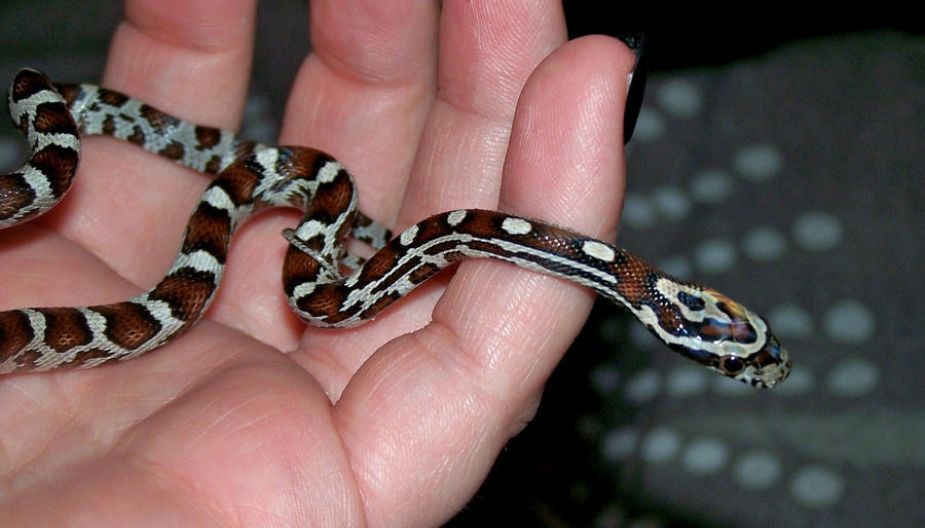Choosing the perfect heat lamp wattage for your corn snake is a delicate balancing act. Your snake's comfort and health depend on it.
Corn snakes require a precise temperature gradient, with a basking spot around 90°F and a cooler area between 75-82°F.
To get it right, consider your enclosure size – a general rule of thumb is 1-2 watts per gallon. But don't rely solely on this guideline.
Instead, accurately monitor the temperature gradient using a reliable thermometer.
Observe your snake's behavior to fine-tune the setup. Where does it spend most of its time? Make adjustments accordingly.
Finally, pick the right bulb type – ceramic heat emitters provide heat without light, which is useful for maintaining proper temperature and humidity levels.
Understand Your Snake's Needs
To choose the right heat lamp wattage, you first need to understand your snake's specific temperature requirements. Corn snakes thrive in environments with a carefully maintained temperature gradient. This means providing a basking spot of around 90°F (32°C) while maintaining the cool side of the enclosure between 75-82°F (24-27°C).
Start by recognizing that your corn snake's health depends on this gradient. A heat lamp is essential to create the warm basking spot needed. To determine the appropriate wattage, keep in mind the general rule: 1-2 watts per gallon of tank space. For instance, a 40-watt bulb is typically suitable for a 20-gallon tank during summer, whereas a 60-watt bulb might be necessary in winter when ambient temperatures drop.
Monitoring the temperature is vital. Place a reliable thermometer directly under the heat lamp to verify the basking spot maintains a temperature between 84-87°F (29-31°C). This provides the warmth your corn snake needs to digest food properly and remain active. Additionally, make certain there's a cool side where the temperature stays within the recommended range. This allows your snake to regulate its body temperature by moving between the warm and cool areas.
Consider Enclosure Size
When choosing the right heat lamp wattage, consider the size of your snake's enclosure to provide a suitable temperature gradient. The tank size directly influences the wattage needed to maintain suitable temperatures for your corn snake.
For instance, a 10-gallon tank typically requires a 20-watt bulb, while a 20-gallon tank needs a 40-watt bulb during the summer and a 60-watt bulb in the winter. If you have a larger, 30-gallon tank, a 60-watt bulb will suffice.
The size of the reptile enclosure determines the wattage of the heat lamp needed to create a proper temperature gradient, which is vital for your corn snake's well-being. A larger enclosure size means more space to heat, necessitating a higher wattage bulb.
As a general rule of thumb, use 2-4 watts of heat lamp per gallon of tank space. This guideline helps you to achieve the desired temperature, guaranteeing your snake stays healthy and comfortable.
In addition to the heat lamp, you might consider using heat mats to supplement heating, especially in larger enclosures. These can help maintain a consistent temperature gradient throughout the tank.
Always monitor the temperature to adjust the wattage accordingly, preventing overheating or underheating.
The substrate you choose also affects heating efficiency. Different substrates can either retain or disperse heat, impacting the overall temperature.
Select a substrate that complements your heating setup, providing an ideal environment for your corn snake.
Monitor Temperature Gradient
Monitoring the temperature gradient in your snake's enclosure guarantees your corn snake can thermoregulate effectively and stay healthy. Providing a proper temperature gradient means your corn snake can choose its preferred temperature zone, which is vital for its well-being.
Start by setting up the heat lamp on the hot side of the enclosure, aiming for temperatures between 84 and 87 degrees Fahrenheit. Use digital probe thermometers to measure the temperature accurately. Place one thermometer probe under the heat lamp on top of the substrate to monitor the basking area. Position another thermometer probe in the cool zone to verify the gradient is correct.
Temperature fluctuations are also important. Mimicking natural conditions means allowing a night-time temperature drop of about 10-15 degrees Fahrenheit. This helps your corn snake to experience a more natural environment.
You might also consider using a heat mat to provide underbelly heat, especially during cooler periods. This can be beneficial to your corn snake's digestion and overall health.
Here's a quick guide to help you set up and monitor the temperature gradient:
| Task | Details |
|---|---|
| Hot Side Temperature | 84-87°F |
| Cool Side Temperature | Natural room temperature |
| Night Temperature Drop | 10-15°F |
| Thermometer Placement | Basking area and cool zone |
| Additional Heating | Heat mat for underbelly heat |
Adjust Based on Behavior
Regularly observe your corn snake's behavior to determine if adjustments to the heat lamp wattage or placement are necessary. Pay attention to where your corn snake spends most of its time. If it consistently stays in the warm hide, the heat source may not be providing adequate warmth. Conversely, if it avoids the warm area, the heat bulb might be too strong, risking severe burns or overheating.
Ensure that the top of the substrate in the snakes enclosure maintains a set temperature range suitable for corn snakes, typically between 75-85°F. A proportional thermostat can be invaluable, as it allows you to control and maintain different temperatures within the enclosure, ensuring a steady and safe environment.
Your corn snake's behavior is a vital indicator of its thermal comfort. If your snake burrows frequently or spends excessive time away from the warm hide, it might be seeking a cooler place, suggesting that the heat source is too intense. Adjust the heat bulb wattage or its placement to achieve a balanced temperature gradient.
Providing a gradient of different temperatures within the enclosure is key. This allows your corn snake to self-regulate its body temperature by moving between warmer and cooler areas. If you notice your snake basking on the top of the substrate more than usual, it could indicate insufficient heat, necessitating an increase in the wattage of your heat bulb.
Always monitor and tweak the heat lamp setup based on these observations. Ensuring your corn snake's comfort will help it thrive, promoting better health and activity levels.
Choose the Right Bulb Type
Selecting the right bulb type is essential for creating a perfect environment for your corn snake. You'll need to consider various factors, such as heat, UVB light, and humidity levels, to ensure your snake thrives.
The type of bulb you choose can significantly impact these elements.
For providing heat, ceramic heat emitters are a popular choice because they produce consistent warmth without emitting light. This allows your corn snake to maintain a proper day-night cycle.
Dome lamps are often used with these bulbs to focus the heat on a specific hot spot in the enclosure. Dome lamps can also house other types of bulbs, like basking bulbs, which provide both light and heat.
UVB light isn't always necessary for corn snakes, but it can be beneficial. If you decide to use UVB lighting, a fluorescent tube is a good option.
These tubes offer a gentle method of heating and provide UVB rays that can help with the overall health of your snake. Just make sure to place the tube at a safe distance to avoid overheating.
When choosing a bulb, also think about the humidity levels in your snake's habitat. Some bulbs can dry out the air, which might require you to monitor and adjust the humidity more frequently.
Conclusion
By considering your corn snake's specific needs, the size of its enclosure, and monitoring the temperature gradient, you'll provide a comfortable environment.
Adjust the heat lamp wattage based on your snake's behavior and choose the right bulb type for ideal results.
These steps will help you provide a safe and effective heating setup for your pet.
Remember, a well-regulated habitat is key to your corn snake's health and happiness.


